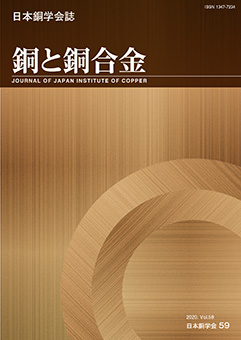Volume 60, Issue 1
Displaying 1-50 of 59 articles from this issue
Papers
Microstructure
-
2021Volume 60Issue 1 Pages 1-6
Published: 2021
Released on J-STAGE: November 17, 2021
Download PDF (1797K) -
2021Volume 60Issue 1 Pages 7-10
Published: 2021
Released on J-STAGE: November 17, 2021
Download PDF (2369K) -
2021Volume 60Issue 1 Pages 11-15
Published: 2021
Released on J-STAGE: November 17, 2021
Download PDF (1582K) -
2021Volume 60Issue 1 Pages 16-23
Published: 2021
Released on J-STAGE: November 17, 2021
Download PDF (3307K) -
2021Volume 60Issue 1 Pages 24-28
Published: 2021
Released on J-STAGE: November 17, 2021
Download PDF (1613K) -
2021Volume 60Issue 1 Pages 29-34
Published: 2021
Released on J-STAGE: November 17, 2021
Download PDF (1802K) -
2021Volume 60Issue 1 Pages 35-40
Published: 2021
Released on J-STAGE: November 17, 2021
Download PDF (1863K) -
2021Volume 60Issue 1 Pages 41-44
Published: 2021
Released on J-STAGE: November 17, 2021
Download PDF (1613K) -
2021Volume 60Issue 1 Pages 45-49
Published: 2021
Released on J-STAGE: November 17, 2021
Download PDF (1898K) -
2021Volume 60Issue 1 Pages 50-55
Published: 2021
Released on J-STAGE: November 17, 2021
Download PDF (3802K) -
2021Volume 60Issue 1 Pages 56-61
Published: 2021
Released on J-STAGE: November 17, 2021
Download PDF (1636K) -
2021Volume 60Issue 1 Pages 62-66
Published: 2021
Released on J-STAGE: November 17, 2021
Download PDF (2373K) -
2021Volume 60Issue 1 Pages 67-73
Published: 2021
Released on J-STAGE: November 17, 2021
Download PDF (3148K) -
2021Volume 60Issue 1 Pages 74-80
Published: 2021
Released on J-STAGE: November 17, 2021
Download PDF (2862K)
Mechanical Propertiesn
-
2021Volume 60Issue 1 Pages 81-86
Published: 2021
Released on J-STAGE: November 17, 2021
Download PDF (2162K) -
2021Volume 60Issue 1 Pages 87-92
Published: 2021
Released on J-STAGE: November 17, 2021
Download PDF (2328K) -
2021Volume 60Issue 1 Pages 93-97
Published: 2021
Released on J-STAGE: November 17, 2021
Download PDF (1140K) -
2021Volume 60Issue 1 Pages 98-103
Published: 2021
Released on J-STAGE: November 17, 2021
Download PDF (2265K)
Electrical Properties
-
2021Volume 60Issue 1 Pages 104-107
Published: 2021
Released on J-STAGE: November 17, 2021
Download PDF (1999K) -
2021Volume 60Issue 1 Pages 108-112
Published: 2021
Released on J-STAGE: November 17, 2021
Download PDF (2099K)
Corrosion, Anticorrosion
-
2021Volume 60Issue 1 Pages 113-118
Published: 2021
Released on J-STAGE: November 17, 2021
Download PDF (2476K) -
2021Volume 60Issue 1 Pages 119-124
Published: 2021
Released on J-STAGE: November 17, 2021
Download PDF (2349K) -
2021Volume 60Issue 1 Pages 125-129
Published: 2021
Released on J-STAGE: November 17, 2021
Download PDF (2065K) -
2021Volume 60Issue 1 Pages 130-134
Published: 2021
Released on J-STAGE: November 17, 2021
Download PDF (945K) -
2021Volume 60Issue 1 Pages 135-139
Published: 2021
Released on J-STAGE: November 17, 2021
Download PDF (2596K) -
2021Volume 60Issue 1 Pages 140-143
Published: 2021
Released on J-STAGE: November 17, 2021
Download PDF (1275K) -
2021Volume 60Issue 1 Pages 144-149
Published: 2021
Released on J-STAGE: November 17, 2021
Download PDF (1807K) -
2021Volume 60Issue 1 Pages 150-156
Published: 2021
Released on J-STAGE: November 17, 2021
Download PDF (2516K)
Melting, Casting
-
2021Volume 60Issue 1 Pages 157-161
Published: 2021
Released on J-STAGE: November 17, 2021
Download PDF (1532K) -
In–situ Observation of Melting and Solidification Behaviors of Cu Powder Caused by Laser Irradiation2021Volume 60Issue 1 Pages 162-166
Published: 2021
Released on J-STAGE: November 17, 2021
Download PDF (5308K) -
2021Volume 60Issue 1 Pages 167-175
Published: 2021
Released on J-STAGE: November 17, 2021
Download PDF (22082K)
Processing
-
2021Volume 60Issue 1 Pages 176-181
Published: 2021
Released on J-STAGE: November 17, 2021
Download PDF (2291K) -
2021Volume 60Issue 1 Pages 182-185
Published: 2021
Released on J-STAGE: November 17, 2021
Download PDF (981K)
Joining
-
2021Volume 60Issue 1 Pages 186-190
Published: 2021
Released on J-STAGE: November 17, 2021
Download PDF (3269K) -
2021Volume 60Issue 1 Pages 191-195
Published: 2021
Released on J-STAGE: November 17, 2021
Download PDF (2840K) -
2021Volume 60Issue 1 Pages 196-201
Published: 2021
Released on J-STAGE: November 17, 2021
Download PDF (1825K) -
2021Volume 60Issue 1 Pages 202-206
Published: 2021
Released on J-STAGE: November 17, 2021
Download PDF (2236K) -
2021Volume 60Issue 1 Pages 207-212
Published: 2021
Released on J-STAGE: November 17, 2021
Download PDF (2756K) -
2021Volume 60Issue 1 Pages 213-217
Published: 2021
Released on J-STAGE: November 17, 2021
Download PDF (2319K)
Plating
-
2021Volume 60Issue 1 Pages 218-222
Published: 2021
Released on J-STAGE: November 17, 2021
Download PDF (1695K) -
2021Volume 60Issue 1 Pages 223-226
Published: 2021
Released on J-STAGE: November 17, 2021
Download PDF (1365K) -
2021Volume 60Issue 1 Pages 227-230
Published: 2021
Released on J-STAGE: November 17, 2021
Download PDF (2050K) -
2021Volume 60Issue 1 Pages 231-234
Published: 2021
Released on J-STAGE: November 17, 2021
Download PDF (2038K)
Antimicrobial Properties
-
2021Volume 60Issue 1 Pages 235-240
Published: 2021
Released on J-STAGE: November 17, 2021
Download PDF (4779K) -
2021Volume 60Issue 1 Pages 241-245
Published: 2021
Released on J-STAGE: November 17, 2021
Download PDF (1169K) -
2021Volume 60Issue 1 Pages 246-249
Published: 2021
Released on J-STAGE: November 17, 2021
Download PDF (1785K)
Heat Transfer, Heat Exchanger
-
2021Volume 60Issue 1 Pages 250-255
Published: 2021
Released on J-STAGE: November 17, 2021
Download PDF (1748K)
Material Development
-
2021Volume 60Issue 1 Pages 256-261
Published: 2021
Released on J-STAGE: November 17, 2021
Download PDF (1504K) -
2021Volume 60Issue 1 Pages 262-265
Published: 2021
Released on J-STAGE: November 17, 2021
Download PDF (1241K)
Composite
-
2021Volume 60Issue 1 Pages 266-270
Published: 2021
Released on J-STAGE: November 17, 2021
Download PDF (1228K)
